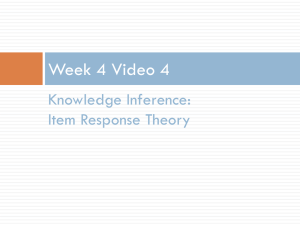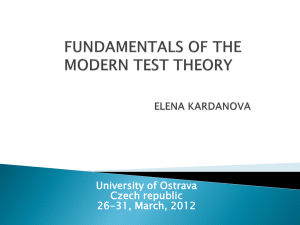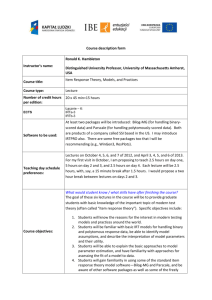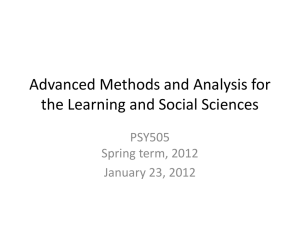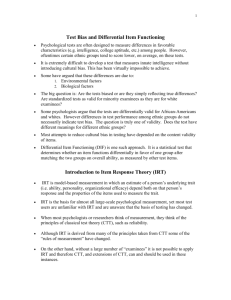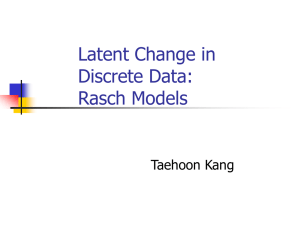Unlike the classical test theory, in which the test scores of the same
advertisement
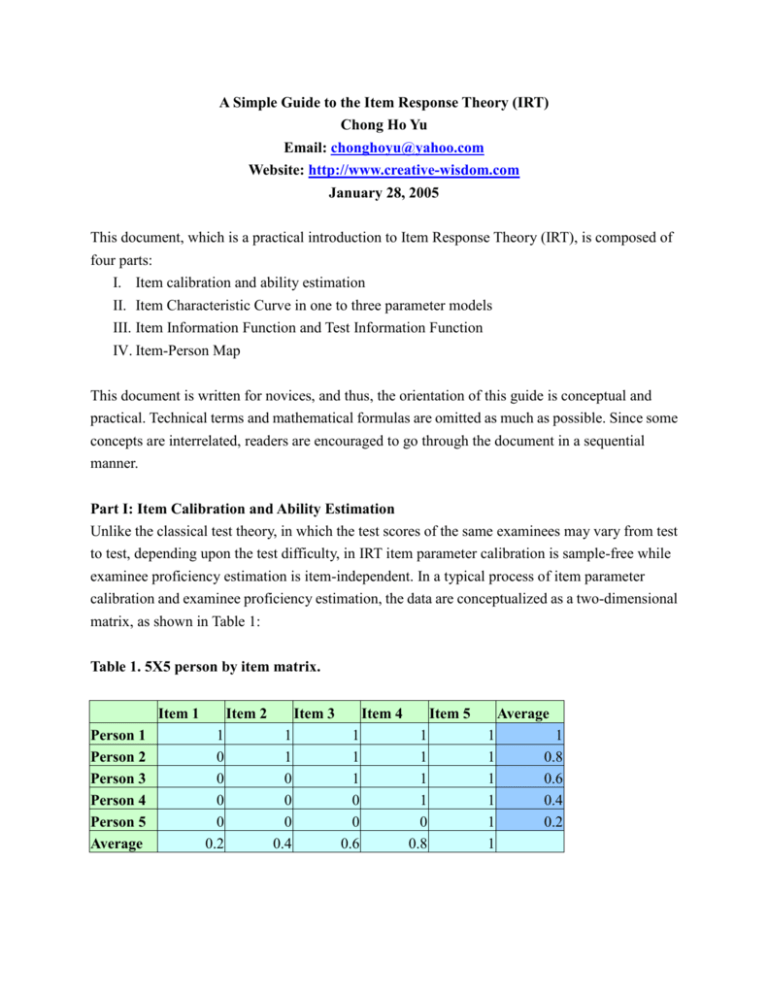
A Simple Guide to the Item Response Theory (IRT) Chong Ho Yu Email: chonghoyu@yahoo.com Website: http://www.creative-wisdom.com January 28, 2005 This document, which is a practical introduction to Item Response Theory (IRT), is composed of four parts: I. Item calibration and ability estimation II. Item Characteristic Curve in one to three parameter models III. Item Information Function and Test Information Function IV. Item-Person Map This document is written for novices, and thus, the orientation of this guide is conceptual and practical. Technical terms and mathematical formulas are omitted as much as possible. Since some concepts are interrelated, readers are encouraged to go through the document in a sequential manner. Part I: Item Calibration and Ability Estimation Unlike the classical test theory, in which the test scores of the same examinees may vary from test to test, depending upon the test difficulty, in IRT item parameter calibration is sample-free while examinee proficiency estimation is item-independent. In a typical process of item parameter calibration and examinee proficiency estimation, the data are conceptualized as a two-dimensional matrix, as shown in Table 1: Table 1. 5X5 person by item matrix. Item 1 Person 1 Person 2 Person 3 Person 4 Person 5 Average Item 2 1 0 0 0 0 0.2 Item 3 1 1 0 0 0 0.4 Item 4 1 1 1 0 0 0.6 Item 5 1 1 1 1 0 0.8 Average 1 1 1 1 1 1 1 0.8 0.6 0.4 0.2 A simple guide to IRT 2 In this example, Person 1, who answered all five items correctly, is tentatively considered as possessing 100% proficiency. Person 2 has 80% proficiency, Person 3 has 60%, etc. These scores in terms of percentage are considered tentative because first, in IRT there is another set of terminology and scaling scheme for proficiency, and second, we cannot judge a person’s ability just based on the number of correct items he obtained. Rather, the item attribute should also be taken into account. In this highly simplified example, no examinees have the same raw scores. But what would happen if there is an examinee, say Person 6, whose raw score is the same as that of Person 4 (see Table 2)? Table 2. Two persons share the same raw scores. 0 0 1 Person 4 Person 5 Person 6 0 0 1 0 0 0 1 0 0 1 1 0 0.4 0.2 0.4 We cannot draw a firm conclusion that they have the same level of proficiency because Person 4 answered two easy items correctly, whereas Person 6 scored two hard questions instead. Nonetheless, for the simplicity of illustration, we will stay with the five-person example. This nice and clean five-person example shows an ideal case, in which proficient examinees score all items, less competent ones score the easier items and fail the hard ones, and poor students fail all. This ideal case is known as the Guttman pattern and rarely happens in reality. If this happens, the result would be considered an overfit. In non-technical words, the result is just “too good to be true.” Table 1 5X5 person by item matrix (with highlighted average) Item 1 Person 1 Person 2 Person 3 Person 4 Person 5 Average Item 2 1 0 0 0 0 0.2 Item 3 1 1 0 0 0 0.4 Item 4 1 1 1 0 0 0.6 Item 5 1 1 1 1 0 0.8 Average 1 1 1 1 1 1 1 0.8 0.6 0.4 0.2 We can also make a tentative assessment of the item attribute based on this ideal-case matrix. Let’s look at Table 1 again. Item 1 seems to be the most difficult because only one person out of A simple guide to IRT 3 five could answer it correctly. Again, it is tentatively asserted that the difficulty level in terms of the passrate for Item 1 is 20%, Item 2 is 40%, etc. This matrix is nice and clean; however, as you might expect, the issue will be very complicated when some items have the same pass rate but are passed by examinees of different levels of proficiency. Table 3. Two items share the same pass rate Item 1 Person 1 Person 2 Person 3 Person 4 Person 5 Average Item 2 1 0 0 0 0 0.2 Item 3 1 1 0 0 0 0.4 Item 4 1 1 1 0 0 0.6 Item 5 1 1 1 1 0 0.8 Item 6 1 1 1 1 1 1 Average 0 0.833333 0 0.666667 0 0.5 0 0.333333 1 0.333333 0.2 In the preceding example (Table 3), Item 1 and Item 6 have the same pass rate (20%) and thus they seem to have the same difficulty level. However, Item 1 was answered correctly by a person who has high proficiency (83%) whereas Item 6 was not (the person who answered it has 33% proficiency). It is possible that the text in Item 6 tends to confuse good students. Therefore, the item attribute of Item 6 is not clear-cut. For convenience of illustration, we call the portion of correct answers for each person “tentative proficiency” and the pass rate for each item “tentative item difficulty.” Please do not confuse these “tentative” numbers with the item difficulty parameter and the person theta in IRT. We will discuss them later. In short, both the item attribute and the examinee proficiency should be taken into consideration in order to conduct item calibration and proficiency estimation. This is an iterative process in the sense that tentative proficiency and difficulty derived from the data are used to fit the model, and then the model is employed to predict the data. Needless to say, there will be some discrepancy between the model and the data in the initial steps. It takes many cycles to reach convergence. Given the preceding tentative information, we can predict the probability of answering a particular item correctly given the proficiency level of an examinee by the following equation: Probability = 1/(1+exp(-(proficiency – difficulty))) Exp is the Exponential Function. In Excel the function is written as exp(). For example: A simple guide to IRT 4 e0 = 1 e1 = 2.7182= exp(1) e2 = 7.3890= exp(2) e3 = 20.0855= exp(3) Now let’s go back to the example depicted in Table 1. By applying the above equation, we can give a probabilistic estimation about how likely a particular person is to answer a specific item correctly: Table 4a. Person 1 is “better” than Item 1 Person 1 Person 2 Person 3 Person 4 Person 5 Tentative Difficulty Tentative Item 1 Item 2 Item 3 Item 4 Item 5 Proficiency 0.689974 0.645656 0.598688 0.549834 0.5 1 0.645656 0.598688 0.549834 0.5 0.450166 0.8 0.598688 0.549834 0.5 0.450166 0.401312 0.6 0.549834 0.5 0.450166 0.401312 0.354344 0.4 0.5 0.450166 0.401312 0.354344 0.310026 0.2 0.2 0.4 0.6 0.8 1 For example, the probability that Person 1 can answer Item 1 correctly is 0.6899. There is no surprise. Person 1 has a tentative proficiency of 1 while the tentative difficulty of Item 1 is 0.2. In other words, he has more than a 50 percent chance to score the item. Person 1 is definitely “smarter” or “better” than Item 1. Table 4b. The person “matches” the item. Person 1 Person 2 Person 3 Person 4 Person 5 Tentative Difficulty Tentative Item 1 Item 2 Item 3 Item 4 Item 5 Proficiency 0.689974 0.645656 0.598688 0.549834 0.5 1 0.645656 0.598688 0.549834 0.5 0.450166 0.8 0.598688 0.549834 0.5 0.450166 0.401312 0.6 0.549834 0.5 0.450166 0.401312 0.354344 0.4 0.5 0.450166 0.401312 0.354344 0.310026 0.2 0.2 0.4 0.6 0.8 1 A simple guide to IRT 5 The probability that Person 5 can answer Item 1 correctly is 0.5. The tentative item difficulty is .2, and the tentative proficiency is also .2. In other words, the person’s ability “matches” the item difficulty. When you move your eyes across the diagonal from lower left to upper right, you will see a “match” (.5) between a person and an item several times. However, when we put Table 1 and Table 4b together, we will find something strange. Table 1 5X5 person by item matrix Item 1 Person 1 Person 2 Person 3 Person 4 Person 5 Average Item 2 1 0 0 0 0 0.2 Item 3 1 1 0 0 0 0.4 Item 4 1 1 1 0 0 0.6 Item 5 1 1 1 1 0 0.8 Average 1 1 1 1 1 1 1 0.8 0.6 0.4 0.2 According to Table 4b, the probability of Person 5 answering Item 5 correctly is .31, while that of answering Item 1 correctly is .5. But actually, Person 5 got no points in Item 1 whereas he obtained one point in Item 5! As mentioned before, the data and the model do not necessarily fit together. This residual information can help a computer program, such as Bilog, to further calibrate the estimation until the data and the model converge. Figure 1 is an example of Bilog’s calibration output, which shows that it takes ten cycles to reach convergence. Figure 1. Bilog’s Phase 2 partial output CALIBRATION PARAMETERS MAXIMUM NUMBER OF EM CYCLES: MAXIMUM NUMBER OF NEWTON CYCLES: CONVERGENCE CRITERION: ACCELERATION CONSTANT: 10 2 0.0100 1.0000 A simple guide to IRT 6 Part II: Item Characteristic Curve (ICC) After the item parameters are estimated, this information can be utilized to model the response pattern of a particular item by using the following equation: P = 1/(1+exp(-(theta – difficulty))) From this point on, we give proficiency a special name: Theta, which is usually denoted by the Greek symbol . After the probabilities of giving the correct answer across different levels of are obtained, the relationship between the probabilities and can be presented as an Item Characteristic Curve (ICC), as shown in Figure 2. Figure 2. Item Characteristic Curve In Figure 2, the x-axis is the theoretical theta (proficiency) level, ranging from -5 to +5. Please keep in mind that this graph represents theoretical modeling rather than empirical data. To be specific, there may not be examinees who can reach a proficiency level of +5 or fail so miserably as to be in the -5 group. Nonetheless, to study the “performance” of an item, we are interested in knowing, given a person whose is +5, what the probability of giving the right answer is. Figure 2 shows a near-ideal case. The ICC indicates that when is zero, which is average, the probability of answering the item correctly is almost .5. When is -5, the probability is almost zero. When is +5, the probability increases to .99. A simple guide to IRT 7 IRT modeling can be as simple as using one parameter or as complicated as using three parameters, namely, A, B, and G parameters. Needless to say, the preceding example is a near-ideal case using only the B (item difficulty) parameter, keeping the A parameter constant and ignoring the G parameter. These three parameters are briefly explained as follows: 1. B parameter: It is also known as the difficulty parameter or the threshold parameter. This value tells us how easy or how difficult an item is. It is used in the one-parameter (1P) IRT model. Figure 3 shows a typical example of a 1P model, in which the ICCs of many items are shown in one plot. One obvious characteristic of this plot is that no two ICCs cross over each other. Figure 3. 1P ICCs. 2. A parameter: It is also called the discrimination parameter. This value tells us how effectively this item can discriminate between highly proficient students and less-proficient students. The two-parameter (2P) IRT model uses both A and B parameters. Figure 4 shows a typical example of a 2P model. As you can notice, this plot is not as nice and clean as the 1P ICC plot, which is manifested by the characteristic that some ICCs cross over each other. A simple guide to IRT 8 Figure 4a. 2P ICC Take Figure 4b (next page) as an example. The red ICC does not have a high discrimination. The probability that examinees whose is +5 can score the item is 0.82, whereas the probability that examinees whose is -5 can score it is 0.48. The difference is just 0.82 - 0.48 = 0.26. On the other hand, the green ICC demonstrates a much better discrimination. In this case, the probability of obtaining the right answer given the of +5 is 1 whereas the probability of getting the correct answer given the of -5 is 0, and thus the difference is 1-0=1. Obviously, the discrimination parameter affects the appearance of the slope of ICCs, and that’s why ICCs in the 2P model would cross over each other. A simple guide to IRT 9 Figure 4b. ICCs of high and low discriminations. However, there is a major drawback in introducing the A parameter into the 2P IRT modeling. In this situation, there is no universal answer to the question “Which item is more difficult?” Take Figure 4b as an example again. For examinees whose is +2, the probability of scoring the red item is 0.7 while the probability of scoring the green item is 0.9. Needless to say, for them the red item is more difficult. For examinees whose is -2, the probability of answering the red item correctly is .6 whereas the probability of giving the correct answer to the green item is .1. For them the green item is more difficult. This phenomenon is called the Lord’s paradox. A simple guide to IRT 10 Figure 5. 3P ICCs 3. C parameter: It is also known as the G parameter or the guessing parameter. This value tells us how likely the examinees are to obtain the correct answer by guessing. A three-parameter (3P) IRT model uses A, B, and G parameters. Figures 5 and 4, which portray a 2P and 3P ICC plots using the same dataset, look very much alike. However, there is a subtle difference. In Figure 5 most items have a higher origin (the statistical term is “intercept”) on the y-axis. When the guessing parameter is taken into account, it shows that in many items, even if the examinee does not know anything about the subject matter (=-5), he or she can still have some chances (p>0) to get the right answer. The rule of thumb is: the more parameters we want to estimate, the more subjects we need in computing. If there are sample size constraints, it is advisable to use a 1P model to conduct test construction and use a 3P as a diagnostic tool only. Test construction based upon the Item Information Function and the Test Information Function will be discussed next. A simple guide to IRT 11 Part III: Item Information Function and Test Information Function Figure 2. ICC Let’s revisit the ICC. When the is 0 (average), the probability of obtaining the right answer is 0.5. When the is 5, the probability is 1; when the is -5, the probability is 0. However, in the last two cases we have the problem of missing information. What does it mean? Imagine that ten competent examinees always answer this item correctly. In this case, we could not tell which candidate is more competent than the others with respect to this domain knowledge. On the contrary, if ten incompetent examinees always fail this item, we also could not tell which students are worse with regard to the subject matter. In other words, we have virtually no information about the in relations to the item parameter at two extreme poles, and less and less information when the moves away from the center toward the two ends. Not surprisingly, if a student answers all items in a test correctly, his could not be estimated. Conversely, if an item is scored by all candidates, its difficulty parameter could not be estimated either. The same problem occurs when all students fail or pass the same item. In this case, no item parameter can be computed. There is a mathematical way to compute how much information each ICC can tell us. This method is called the Item Information Function (IIF). The meaning of information can be traced back to R. A. Fisher’s notion that information is defined as the reciprocal of the precision with which a parameter is estimated. If one could estimate a parameter with precision, one could know more about the value of the parameter than if one had estimated it with less precision. The precision is a A simple guide to IRT 12 function of the variability of the estimates around the parameter value. In other words, it is the reciprocal of the variance. The formula is as follows: Information = 1/(variance) In a dichotomous situation, the variance is p(1-p) whereas p = parameter value. Based on the item parameter values, one could compute and plot the IIFs for the items as shown in Figure 6. Figure 6. Item Information Functions 0.3 0.25 0.2 IIF Item 1 0.15 Item 2 Item 3 0.1 0.05 0 T-5 T-4 T-3 T-2 T-1 T0 T1 T2 T3 T4 T5 Theta For clarity, only the IIFs of three items of a particular test are shown in Figure 6. Obviously, these IIFs differ from each other. In Item 1 (the blue line), the “peak” information can be found when the level is -1. When the is -5, there is still some amount of information (0.08). But there is virtually no information when the is 5. In item 2 (the pink line), most information is centered at zero while the amount of information in the lowest is the same as that in the highest . Item 3 (the yellow line) is the opposite of Item 1. One could have much information near the higher , but information drops substantively as the approaches the lower end. The Test Information Function (TIF) is simply the sum of all IIFs in the test. While IIF can tell us the information and precision of a particular item parameter, the TIF can tell us the same thing at the exam level. When there is more than one alternate form for the same exam, TIF can be used to balance alternate forms. The goal is to make all alternate forms carry the same values of TIF across A simple guide to IRT all levels of theta, as shown in Figure 7. Figure 7. Form balancing using the Test Information Functions. Test Information Functions 12 10 A 8 B 6 C D 4 2 0 -5 -4 -3 -2 -1 0 1 2 3 4 5 13 A simple guide to IRT 14 Part IV Logit and Item-Person Map One of the beautiful features of the IRT is that item and examinee attributes can be presented on the same scale, which is known as the logit. Before explaining the logit, it is essential to explain the odd ratio. The odd ratio is the ratio of the probability of the desired event to the probability of the non-desired event. For example, if the pass rate of an item is one of out five candidates, the desired outcome is passing the item (1 count) and the non-desired outcome is failing the question (4 counts). In this case, the odd ratio is 1:4 = 0.25 As you notice, there is a difference between the probability and the odd. In this example, the probability is 1/5, which is 0.20. The relationships between probabilities (p) and odds are expressed in the following equations: Odds = P/(1-P) = 0.20/(1-0.20) = 0.25 P=Odds/(1+Odds) = 0.25/(1+0.25) = 0.20 The logit is the natural logarithmic scale of the odd ratio, which is expressed as: Logit = Log(Odds) As mentioned before, in IRT modeling we can put the item and examinee attributes on the same scale. But how can we compare apples and oranges? The trick is to convert the values from two measures into a common scale: logit. One of the problems of scaling is that spacing in one portion of the scale is not necessarily comparable to spacing in another portion of the same scale. To be specific, the difference between two items in terms of difficulty near the midpoint of the test (e.g. 50% and 55%) does not equal the gap between two items at the top (e.g. 95% and 100%) or at the bottom (5% and 10%). Take weight reduction as a metaphor: It is easier for me to reduce my weight from 150 lbs to 125 lbs, but it is much more difficult to trim my weight from 125 lbs to 100 lbs. However, people routinely misperceive that distances in raw scores are comparable. By the same token, spacing in one scale is not comparable to spacing in another scale. Rescaling by logit solves both problems. However, it is important to point out that while the concept of logit is applied to both person and item attributes, the computational method for person and item metrics are slightly different. For persons, the odd ratio is P(1-P) whereas for items that is (1-P)/P. In the logit scale, the original spacing is compressed, and as a result, equal intervals can be found on the logit scale, as shown in Table 5: A simple guide to IRT 15 Table 5. Spacing in the original and the Log scale Original 1 2 5 10 20 50 Unequal spacing n/a 2-1 1 5-2 3 10-5 5 20-10 10 50-20 30 Log 0 0.30103 0.69897 1 1.30103 1.69897 Equal Spacing n/a 0.30103-0 0.30103 0.69897-0.30103 0.39794 1-0.69897 0.30103 1.30103-1 0.30103 1.69897-1.30103 0.39794 In an IRT software application named Winsteps, the item difficulty parameter and the examinee theta are expressed in the logit scale and their relationships are presented in the Item-Person Map (IPM), in which both types of information can be evaluated simultaneously. Figure 8 is a typical example of IPM. In Figure 8, observations on the left hand side are examinee proficiency values whereas those on the right hand side are item parameter values. This IPM can tell us the “big picture” of both items and students. The examinees on the upper left are said to be “better” or “smarter” than the items on the lower right, which mean that those easier items are not difficult enough to challenge those highly proficient students. On the other hand, the items on the upper right outsmart examinees on the lower left, which implies that these tough items are beyond their ability level. In this example, the examinees overall are “better” than the exam items. If we draw a red line at zero, we can see that examinees who are below average would miss a small chunk of items (the grey area) but pass a much larger chunk (the pink area). A simple guide to IRT 16 Figure 8. Item-Person Map Conclusion To conclude this tutorial, I would like to highlight one of the advantages of the Item Response Theory. As you can notice in the preceding item-person map, the distribution of the person logit is not highly non-normal even though the items are very easy. And this is the beauty of IRT. In IRT, item difficulty parameters are independent of who take the item whereas examinee thetas are independent of what items the examinees take. Consider Figure 9, which shows the distribution of test scores in the classical sense. The distribution is skew toward the high end. In terms of the classical analysis, we can assert that most examinees have high ability. Hence, it is obvious that estimation of ability depends on what items they take. If the test is easy, it makes them look smart. A simple guide to IRT 17 Figure 9. Raw score distribution in the classical sense Now let’s look at Figure 10, which is a histogram depicting the theta (estimation of examinee ability based upon IRT) with reference to the same exam. In contrast to Figure 9, the distribution is almost bell-shaped because ability estimation in IRT takes item difficulty into account. If you are so lucky that the test is easy, your estimated ability level would not get higher than what it should be. In other words, ability estimation is item-independent. The same principle is applied to item difficulty estimation. The item in which many competent people fail would not appear to be more difficult than what it should be. Thus, item difficulty estimation is said to be sample-independent. A simple guide to IRT Figure 10. Theta distribution based on IRT 18
